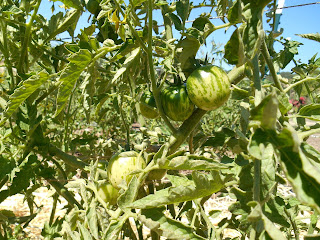Here we are in July, officially summer and we are in full swing at the farm.
We may still be doing some planting, mostly to spread out what is harvested when,
but we are pretty much planted for the season.
As you know, we consciously chose to go a little tomato crazy,
but who can blame us?
The farm at Imagery Estate Winery is just a perfect spot
and then there's you and what we know you crave.
 |
| Heirloom tomato and watermelon salad photo by Steven Krause for Plats du Jour: the girl & the fig's Journey Through the Seasons in Wine Country |
 |
| Heirloom tomatoes & mozzerella at the girl & the fig |
We've noticed something very interesting this year
among the 800 tomatoes we are growing:
 |
| you can get lost in our "tomato alley" |
Some of the tomato plants are shooting up so fast, from first planting day, to the next week, they were growing so tall—some of them are almost up to six fee already,
even before the fruits are ready to be picked. Then there are others,
that are certainly abundant, lush and healthy, but seem to be growing more slowly.
The slower growing ones are all heirlooms and the faster growing ones
are all the hybrids we experimented with this year.
 |
| you can see the difference in heights of the tomato plants |
Since this is our first time growing hybrids, we didn't know what to expect.
In the past, we were purists planting only heirloom tomatoes,
but this year, knowing we would devote so much of the farm space to tomatoes,
we decided to give the hybrids a try.
 |
| Executive Chef John Toulze checks on the hybrids about 2 weeks ago They were almost as tall as he is! |
While you mostly think hybrids are a "dirty word," and only found in supermarkets,
actually, we grew ours from seeds exactly as we did with our heirlooms.
And for the real "tomato dirt" on the subject, check out what Tomato Dirt blog
says about the pros and cons of heirlooms vs. hybrids.
 |
| They are called hybrids because they combine two varieties and you get the best qualities of both "parents." |
KQED Science page shares differences between heirlooms and hybrids
as well as busting a few myths about heirloom tomatoes—such as,
they are not "old fashioned tomatoes," as much as they are
varieties that have had no crossbreeding for 40 years.
 |
| we hope to be serving these to you very soon! |
Did you know that 93% of American households grow tomatoes?
Do you? What kind?
But, as we've been saying, our veggie bowl has more than just tomatoes in it.
We are growing many varieties of squash, several cucumbers,
beans, eggplant and peppers.
And the gift of summer is that we are now beginning to truly see
the fruits of our labors.
 |
| most of what's planted certainly has been planned. And then, we find bountiful purslane just appearing but our chefs get very creative with this! |
 |
| this purple flower will soon be an Ping Tung Eggplant |
 |
| You have to look close but there are lovely padron peppers amongst the leaves already |
 |
| beans |
 |
| lemon cucumber growing in the Orchard bed |
Now into our third year at the
farm, we have a sense
of what grows best where. And while we still like to experiment a bit,
the deepening of our relationship with the farm (as well as knowing what our guests
like to have at their tables), directs what we plant.
But it's hard not to get carried away
and want to plant everything.
We really related to a recent post by Smart Gardener:
"Remember
when you were a kid, and the holidays or your birthday
rolled around—that excitement about looking through the catalogs
circling the toys you just had to
have?
And then the excitement as the
gift-receiving day got closer and closer,
the wonderfully delicious wondering
of what would be wrapped up for you?
I think the closest thing to that
hopeful anxiety is the feeling
gardeners get as they spend the winter months
pouring over seed catalogs
and making endless lists of what they want to
plant this year,
and then waiting for the seeds to arrive."
Here's
a rundown of what they
finally decided to grow this spring and summer.
We've shared our garden plan with you.
What are you
growing in your garden?


































